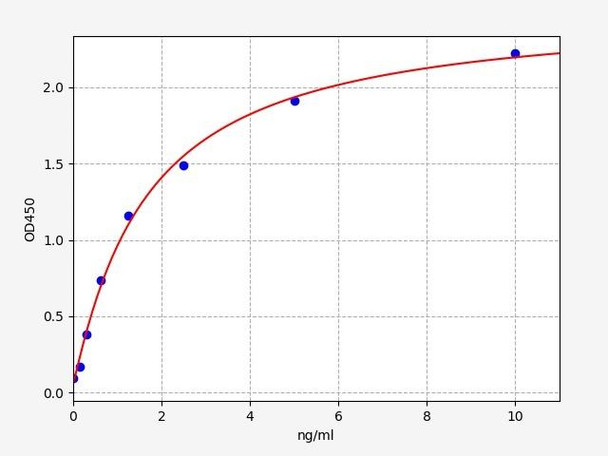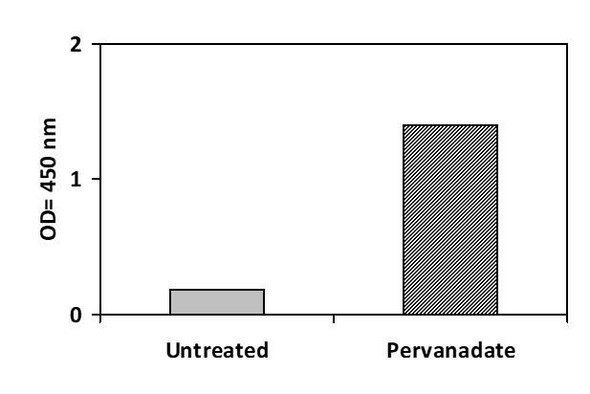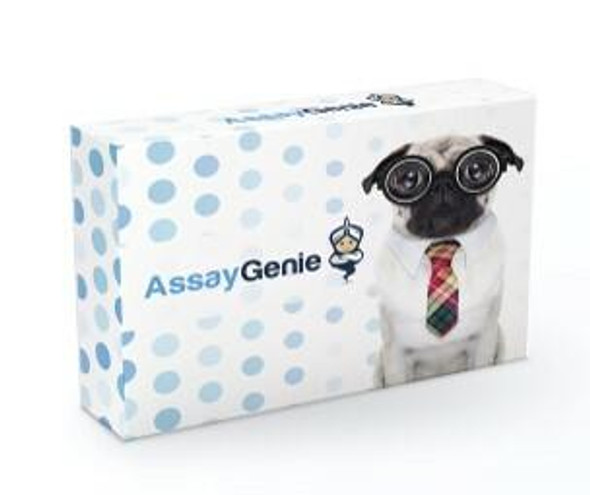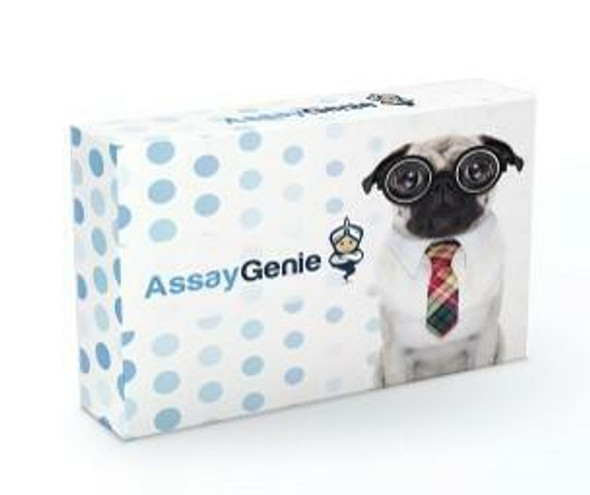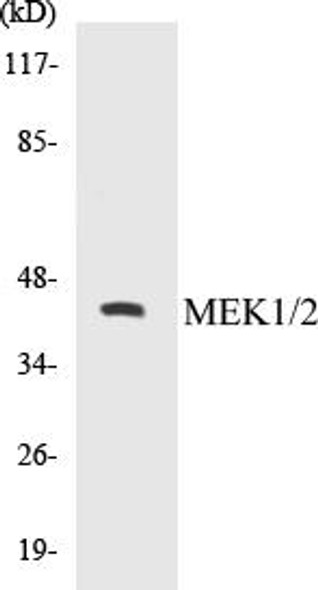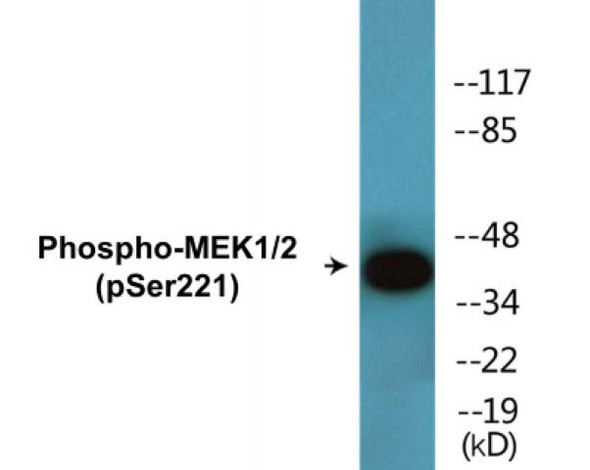Human MEK1 ELISA Kit
- SKU:
- HUFI00419
- Product Type:
- ELISA Kit
- Size:
- 96 Assays
- Uniprot:
- Q02750
- Sensitivity:
- 0.094ng/ml
- Range:
- 0.156-10ng/ml
- ELISA Type:
- Sandwich
- Synonyms:
- MAP2K1, MEK1, MKK1, dual specificity mitogen-activated protein kinase kinase 1, ERK activator kinase 1, MAP kinase kinase 1, MAPK, ERK kinase 1, MAPKK1, MEK1MAPKK 1, mitogen-activated protein kinase kinase 1, MKK1MEK 1, PRKMK1, protein kinase, mitoge
- Reactivity:
- Human
- Research Area:
- Cell Biology
Description
Human MEK1 ELISA Kit
The Human MEK1 ELISA Kit is a reliable and sensitive tool for the quantitative detection of MEK1 levels in human serum, plasma, and cell culture supernatants. This kit offers high specificity and accuracy, providing consistent and reproducible results for a variety of research applications.MEK1, also known as Mitogen-Activated Protein Kinase Kinase 1, plays a critical role in cell signaling pathways regulating cell growth, proliferation, and differentiation. Dysregulation of MEK1 activity has been implicated in various diseases, including cancer, inflammatory disorders, and cardiovascular diseases.
Therefore, accurate measurement of MEK1 levels can provide valuable insights into disease progression and potential therapeutic targets.The Human MEK1 ELISA Kit is easy to use and offers a wide dynamic range, making it suitable for laboratories conducting research on MEK1 signaling pathways, drug development, and biomarker discovery. Trust in the reliability and precision of this ELISA kit for your research needs.
| Product Name: | Human MEK1 ELISA Kit |
| Product Code: | HUFI00419 |
| Size: | 96 Assays |
| Alias: | MAP2K1, MEK1, MKK1, dual specificity mitogen-activated protein kinase kinase 1, ERK activator kinase 1, MAP kinase kinase 1, MAPK, ERK kinase 1, MAPKK1, MEK1MAPKK 1, mitogen-activated protein kinase kinase 1, MKK1MEK 1, PRKMK1, protein kinase, mitogen-activated, kinase 1, MAP kinase kinase 1 |
| Detection method: | Sandwich ELISA, Double Antibody |
| Application: | This immunoassay kit allows for the in vitro quantitative determination of Human MAP2K1 concentrations in serum plasma and other biological fluids. |
| Sensitivity: | 0.094ng/ml |
| Range: | 0.156-10ng/ml |
| Storage: | 4°C for 6 months |
| Note: | For Research Use Only |
| Recovery: | Matrices listed below were spiked with certain level of Human MAP2K1 and the recovery rates were calculated by comparing the measured value to the expected amount of Human MAP2K1 in samples. | ||||||||||||||||
| |||||||||||||||||
| Linearity: | The linearity of the kit was assayed by testing samples spiked with appropriate concentration of Human MAP2K1 and their serial dilutions. The results were demonstrated by the percentage of calculated concentration to the expected. | ||||||||||||||||
| |||||||||||||||||
| CV(%): | Intra-Assay: CV<8% Inter-Assay: CV<10% |
| Component | Quantity | Storage |
| ELISA Microplate (Dismountable) | 8×12 strips | 4°C for 6 months |
| Lyophilized Standard | 2 | 4°C/-20°C |
| Sample/Standard Dilution Buffer | 20ml | 4°C |
| Biotin-labeled Antibody(Concentrated) | 120ul | 4°C (Protect from light) |
| Antibody Dilution Buffer | 10ml | 4°C |
| HRP-Streptavidin Conjugate(SABC) | 120ul | 4°C (Protect from light) |
| SABC Dilution Buffer | 10ml | 4°C |
| TMB Substrate | 10ml | 4°C (Protect from light) |
| Stop Solution | 10ml | 4°C |
| Wash Buffer(25X) | 30ml | 4°C |
| Plate Sealer | 5 | - |
Other materials and equipment required:
- Microplate reader with 450 nm wavelength filter
- Multichannel Pipette, Pipette, microcentrifuge tubes and disposable pipette tips
- Incubator
- Deionized or distilled water
- Absorbent paper
- Buffer resevoir
| Uniprot | Q02750 |
| UniProt Protein Function: | MEK1: a dual-specificity protein kinase of the STE7 kinase family. Phosphorylated and activated by Raf, Mos and Cot kinases. Phosphorylates a Thr and a Tyr residue in a Thr-Glu-Tyr sequence located in the activation loop of ERK1 and ERK2. An essential component of MAP kinase signal transduction pathways involved in many cellular processes such as proliferation, differentiation, transcription regulation and development. |
| UniProt Protein Details: | Protein type:EC 2.7.12.2; Protein kinase, dual-specificity (non-receptor); Kinase, protein; Protein kinase, STE; STE group; STE7 family Chromosomal Location of Human Ortholog: 15q22.1-q22.33 Cellular Component: dendrite cytoplasm; Golgi apparatus; microtubule; focal adhesion; mitochondrion; endoplasmic reticulum; early endosome; perikaryon; cell cortex; cytosol; axon; perinuclear region of cytoplasm; late endosome; cytoplasm; plasma membrane; microtubule organizing center; nucleus Molecular Function:MAP kinase kinase activity; protein serine/threonine kinase activity; protein serine/threonine kinase activator activity; protein binding; Ras GTPase binding; receptor signaling protein tyrosine phosphatase activity; protein-tyrosine kinase activity; protein serine/threonine/tyrosine kinase activity; mitogen-activated protein kinase kinase kinase binding; ATP binding; protein kinase activity Biological Process: axon guidance; peptidyl-tyrosine phosphorylation; activation of MAPKK activity; nerve growth factor receptor signaling pathway; activation of MAPK activity; protein heterooligomerization; negative regulation of homotypic cell-cell adhesion; response to glucocorticoid stimulus; stress-activated MAPK cascade; cell motility involved in cell locomotion; pathogenesis; toll-like receptor 3 signaling pathway; signal transduction; chemotaxis; toll-like receptor 10 signaling pathway; toll-like receptor 5 signaling pathway; neuron differentiation; negative regulation of cell proliferation; positive regulation of RNA elongation from RNA polymerase II promoter; small GTPase mediated signal transduction; vesicle transport along microtubule; response to axon injury; cell cycle arrest; toll-like receptor 4 signaling pathway; Golgi inheritance; epidermal growth factor receptor signaling pathway; mitosis; fibroblast growth factor receptor signaling pathway; MyD88-independent toll-like receptor signaling pathway; MAPKKK cascade; melanosome transport; toll-like receptor 2 signaling pathway; MyD88-dependent toll-like receptor signaling pathway; keratinocyte differentiation; cell proliferation; regulation of stress-activated MAPK cascade; regulation of vascular smooth muscle contraction; Ras protein signal transduction; insulin receptor signaling pathway; toll-like receptor signaling pathway; innate immune response; toll-like receptor 9 signaling pathway; response to oxidative stress; positive regulation of Ras protein signal transduction; cell motility; positive regulation of cell differentiation; vascular endothelial growth factor receptor signaling pathway; positive regulation of cell migration Disease: Noonan Syndrome 1; Cardiofaciocutaneous Syndrome 3 |
| NCBI Summary: | The protein encoded by this gene is a member of the dual specificity protein kinase family, which acts as a mitogen-activated protein (MAP) kinase kinase. MAP kinases, also known as extracellular signal-regulated kinases (ERKs), act as an integration point for multiple biochemical signals. This protein kinase lies upstream of MAP kinases and stimulates the enzymatic activity of MAP kinases upon wide variety of extra- and intracellular signals. As an essential component of MAP kinase signal transduction pathway, this kinase is involved in many cellular processes such as proliferation, differentiation, transcription regulation and development. [provided by RefSeq, Jul 2008] |
| UniProt Code: | Q02750 |
| NCBI GenInfo Identifier: | 400274 |
| NCBI Gene ID: | 5604 |
| NCBI Accession: | Q02750.2 |
| UniProt Related Accession: | Q02750 |
| Molecular Weight: | 393 |
| NCBI Full Name: | Dual specificity mitogen-activated protein kinase kinase 1 |
| NCBI Synonym Full Names: | mitogen-activated protein kinase kinase 1 |
| NCBI Official Symbol: | MAP2K1Â Â |
| NCBI Official Synonym Symbols: | CFC3; MEK1; MKK1; MAPKK1; PRKMK1Â Â |
| NCBI Protein Information: | dual specificity mitogen-activated protein kinase kinase 1; MEK 1; MAPKK 1; MAPK/ERK kinase 1; ERK activator kinase 1; protein kinase, mitogen-activated, kinase 1 (MAP kinase kinase 1) |
| UniProt Protein Name: | Dual specificity mitogen-activated protein kinase kinase 1 |
| UniProt Synonym Protein Names: | ERK activator kinase 1; MAPK/ERK kinase 1; MEK 1 |
| UniProt Gene Name: | MAP2K1Â Â |
| UniProt Entry Name: | MP2K1_HUMAN |
*Note: Protocols are specific to each batch/lot. For the correct instructions please follow the protocol included in your kit.
Before adding to wells, equilibrate the SABC working solution and TMB substrate for at least 30 min at 37°C. When diluting samples and reagents, they must be mixed completely and evenly. It is recommended to plot a standard curve for each test.
| Step | Protocol |
| 1. | Set standard, test sample and control (zero) wells on the pre-coated plate respectively, and then, record their positions. It is recommended to measure each standard and sample in duplicate. Wash plate 2 times before adding standard, sample and control (zero) wells! |
| 2. | Aliquot 0.1ml standard solutions into the standard wells. |
| 3. | Add 0.1 ml of Sample / Standard dilution buffer into the control (zero) well. |
| 4. | Add 0.1 ml of properly diluted sample ( Human serum, plasma, tissue homogenates and other biological fluids.) into test sample wells. |
| 5. | Seal the plate with a cover and incubate at 37 °C for 90 min. |
| 6. | Remove the cover and discard the plate content, clap the plate on the absorbent filter papers or other absorbent material. Do NOT let the wells completely dry at any time. Wash plate X2. |
| 7. | Add 0.1 ml of Biotin- detection antibody working solution into the above wells (standard, test sample & zero wells). Add the solution at the bottom of each well without touching the side wall. |
| 8. | Seal the plate with a cover and incubate at 37°C for 60 min. |
| 9. | Remove the cover, and wash plate 3 times with Wash buffer. Let wash buffer rest in wells for 1 min between each wash. |
| 10. | Add 0.1 ml of SABC working solution into each well, cover the plate and incubate at 37°C for 30 min. |
| 11. | Remove the cover and wash plate 5 times with Wash buffer, and each time let the wash buffer stay in the wells for 1-2 min. |
| 12. | Add 90 µl of TMB substrate into each well, cover the plate and incubate at 37°C in dark within 10-20 min. (Note: This incubation time is for reference use only, the optimal time should be determined by end user.) And the shades of blue can be seen in the first 3-4 wells (with most concentrated standard solutions), the other wells show no obvious color. |
| 13. | Add 50 µl of Stop solution into each well and mix thoroughly. The color changes into yellow immediately. |
| 14. | Read the O.D. absorbance at 450 nm in a microplate reader immediately after adding the stop solution. |
When carrying out an ELISA assay it is important to prepare your samples in order to achieve the best possible results. Below we have a list of procedures for the preparation of samples for different sample types.
| Sample Type | Protocol |
| Serum | If using serum separator tubes, allow samples to clot for 30 minutes at room temperature. Centrifuge for 10 minutes at 1,000x g. Collect the serum fraction and assay promptly or aliquot and store the samples at -80°C. Avoid multiple freeze-thaw cycles. If serum separator tubes are not being used, allow samples to clot overnight at 2-8°C. Centrifuge for 10 minutes at 1,000x g. Remove serum and assay promptly or aliquot and store the samples at -80°C. Avoid multiple freeze-thaw cycles. |
| Plasma | Collect plasma using EDTA or heparin as an anticoagulant. Centrifuge samples at 4°C for 15 mins at 1000 × g within 30 mins of collection. Collect the plasma fraction and assay promptly or aliquot and store the samples at -80°C. Avoid multiple freeze-thaw cycles. Note: Over haemolysed samples are not suitable for use with this kit. |
| Urine & Cerebrospinal Fluid | Collect the urine (mid-stream) in a sterile container, centrifuge for 20 mins at 2000-3000 rpm. Remove supernatant and assay immediately. If any precipitation is detected, repeat the centrifugation step. A similar protocol can be used for cerebrospinal fluid. |
| Cell culture supernatant | Collect the cell culture media by pipette, followed by centrifugation at 4°C for 20 mins at 1500 rpm. Collect the clear supernatant and assay immediately. |
| Cell lysates | Solubilize cells in lysis buffer and allow to sit on ice for 30 minutes. Centrifuge tubes at 14,000 x g for 5 minutes to remove insoluble material. Aliquot the supernatant into a new tube and discard the remaining whole cell extract. Quantify total protein concentration using a total protein assay. Assay immediately or aliquot and store at ≤ -20 °C. |
| Tissue homogenates | The preparation of tissue homogenates will vary depending upon tissue type. Rinse tissue with 1X PBS to remove excess blood & homogenize in 20ml of 1X PBS (including protease inhibitors) and store overnight at ≤ -20°C. Two freeze-thaw cycles are required to break the cell membranes. To further disrupt the cell membranes you can sonicate the samples. Centrifuge homogenates for 5 mins at 5000xg. Remove the supernatant and assay immediately or aliquot and store at -20°C or -80°C. |
| Tissue lysates | Rinse tissue with PBS, cut into 1-2 mm pieces, and homogenize with a tissue homogenizer in PBS. Add an equal volume of RIPA buffer containing protease inhibitors and lyse tissues at room temperature for 30 minutes with gentle agitation. Centrifuge to remove debris. Quantify total protein concentration using a total protein assay. Assay immediately or aliquot and store at ≤ -20 °C. |
| Breast Milk | Collect milk samples and centrifuge at 10,000 x g for 60 min at 4°C. Aliquot the supernatant and assay. For long term use, store samples at -80°C. Minimize freeze/thaw cycles. |

